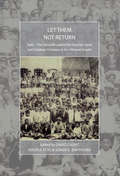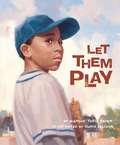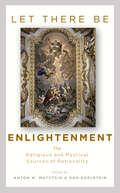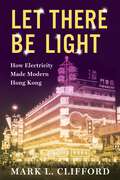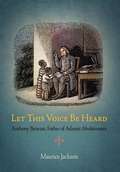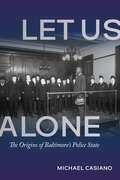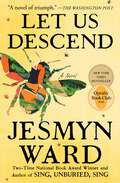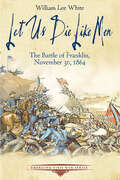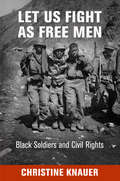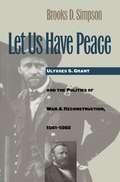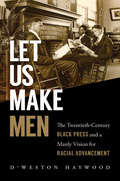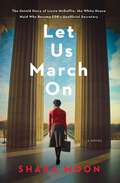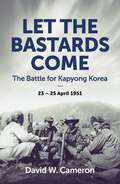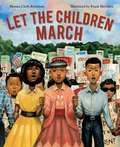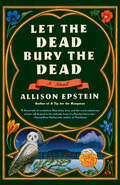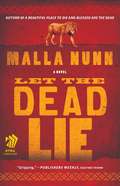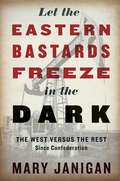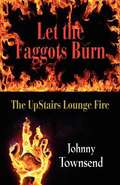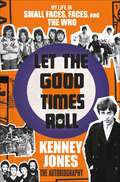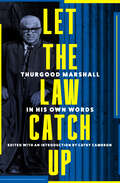- Table View
- List View
Let Them Eat Promises: The Politics of Hunger in America
by Nick KotzGround-breaking history on the politics of hunger in the United States. Kolz asks who is hungry, why, and how can this be changed.
Let Them Not Return: Sayfo â The Genocide Against the Assyrian, Syriac, and Chaldean Christians in the Ottoman Empire (War and Genocide #26)
by David Gaunt Naures Atto Soner O. BarthomaThe mass killing of Ottoman Armenians is today widely recognized, both within and outside scholarly circles, as an act of genocide. What is less well known, however, is that it took place within a broader context of Ottoman violence against minority groups during and after the First World War. Among those populations decimated were the indigenous Christian Assyrians (also known as Syriacs or Chaldeans) who lived in the borderlands of present-day Turkey, Iran, and Iraq. This volume is the first scholarly edited collection focused on the Assyrian genocide, or "Sayfo" (literally, "sword" in Aramaic), presenting historical, psychological, anthropological, and political perspectives that shed much-needed light on a neglected historical atrocity.
Let Them Play (Tales of Young Americans)
by Margot Theis Raven Chris Ellison<p>Segregated Charleston, SC, 1955: There are 62 official Little League programs in South Carolina -- all but one of the leagues is composed entirely of white players. The Cannon Street YMCA All-Stars, an all-black team, is formed in the hopes of playing in the state's annual Little League Tournament. What should have been a time of enjoyment, however, turns sour when all of the other leagues refuse to play against them and even pull out of the program. <p>As the only remaining Little League team in the state, Cannon Street was named state winner by default, giving the boys a legitimate spot in the Little League Baseball World Series held in Williamsport, Pennsylvania. While the Cannon Street team is invited to the game as guests, they are not allowed to participate since they have not officially "played" and won their state's tournament. <p>Let Them Play takes its name from the chant shouted by the spectators who attended the World Series final. Author Margot Theis Raven recounts the inspiring tales of the Cannon Street All-Stars as they arrived in Williamsport, PA and never got the chance to play for the title thanks to the bigotry and ignorance of the South Carolina teams. Winning by forfeit, the Cannon Streeters were subsequently not allowed to participate in Williamsburg because they had not "played" their way into the tournament. <p>Let Them Play is an important civil rights story in American history with an even more important message about equality and tolerance. It's a tale of humanity against the backdrop of America's favorite pastime that's sure to please fans of the sport and mankind. This summer will mark the 50th year since the fans' shouts of Let Them Play fell on deaf ears and 14 boys learned a cruel lesson in backwards politics and prejudice. <p>This book can help teach us a new lesson and assure something like this never happens again.</p>
Let There Be Enlightenment: The Religious and Mystical Sources of Rationality
by Edited by Anton M. Matytsin and Dan EdelsteinChallenging the triumphalist narrative of Enlightenment secularism.According to most scholars, the Enlightenment was a rational awakening, a radical break from a past dominated by religion and superstition. But in Let There Be Enlightenment, Anton M. Matytsin, Dan Edelstein, and the contributors they have assembled deftly undermine this simplistic narrative. Emphasizing the ways in which religious beliefs and motivations shaped philosophical perspectives, essays in this book highlight figures and topics often overlooked in standard genealogies of the Enlightenment. The volume underscores the prominent role that religious discourses continued to play in major aspects of seventeenth- and eighteenth-century thought. The essays probe a wide range of subjects, from reformer Jan Amos Comenius’s quest for universal enlightenment to the changing meanings of the light metaphor, Quaker influences on Baruch Spinoza’s theology, and the unexpected persistence of Aristotle in the Enlightenment. Exploring the emergence of historical consciousness among Enlightenment thinkers while examining their repeated insistence on living in an enlightened age, the collection also investigates the origins and the long-term dynamics of the relationship between faith and reason. Providing an overview of the rich spectrum of eighteenth-century culture, the authors demonstrate that religion was central to Enlightenment thought. The term "enlightenment" itself had a deeply religious connotation. Rather than revisiting the celebrated breaks between the eighteenth century and the period that preceded it, Let There Be Enlightenment reveals the unacknowledged continuities that connect the Enlightenment to its various antecedents.Contributors: Philippe Buc, William J. Bulman, Jeffrey D. Burson, Charly Coleman, Dan Edelstein, Matthew T. Gaetano, Howard Hotson, Anton M. Matytsin, Darrin M. McMahon, James Schmidt, Céline Spector, Jo Van Cauter
Let There Be Light: How Electricity Made Modern Hong Kong (Center on Global Energy Policy Series)
by Mark CliffordThe remarkable success of twentieth-century Hong Kong was driven by electricity. The British colony’s stunning export-driven economic growth, its status as a Cold War capitalist dynamo, its energetic civil society, its alluring urban modernity—all of these are stories of electricity’s transformative power.Let There Be Light is a groundbreaking history of electrification in Hong Kong. Mark L. Clifford traces how a power company and its visionary founder jumpstarted Hong Kong’s postwar economic rise and set in motion far-reaching political and social change against the backdrop of Hong Kong’s shifting relations with the People’s Republic of China and the United Kingdom. Clifford examines avowedly laissez-faire Hong Kong’s attempt to nationalize electricity companies and the longer-term implications of debates over the power supply for citizen activism and the development of civil society, government involvement in tackling housing and other social issues, and state controls on private businesses.Clifford explores the effects of electrification on both grand politics and daily life. In the geopolitical struggle of the Cold War, Hong Kong became an explicitly anti-Communist showcase of production and consumption. Its bright lights and neon signs stood in contrast to the darkness and drabness of neighboring China. Electricity transformed people’s everyday lives, allowing children to study at night, streets to be lit, and shops in a self-consciously commercial mecca to stay open late.Offering new perspectives on twentieth-century Hong Kong, Let There Be Light reveals electricity as a catalyst of modernization.
Let This Voice Be Heard
by Maurice JacksonAnthony Benezet (1713-84), universally recognized by the leaders of the eighteenth-century antislavery movement as its founder, was born to a Huguenot family in Saint-Quentin, France. As a boy, Benezet moved to Holland, England, and, in 1731, Philadelphia, where he rose to prominence in the Quaker antislavery community.In transforming Quaker antislavery sentiment into a broad-based transatlantic movement, Benezet translated ideas from diverse sources--Enlightenment philosophy, African travel narratives, Quakerism, practical life, and the Bible--into concrete action. He founded the African Free School in Philadelphia, and such future abolitionist leaders as Absalom Jones and James Forten studied at Benezet's school and spread his ideas to broad social groups. At the same time, Benezet's correspondents, including Benjamin Franklin, Benjamin Rush, Abbé Raynal, Granville Sharp, and John Wesley, gave his ideas an audience in the highest intellectual and political circles.In this wide-ranging intellectual biography, Maurice Jackson demonstrates how Benezet mediated Enlightenment political and social thought, narratives of African life written by slave traders themselves, and the ideas and experiences of ordinary people to create a new antislavery critique. Benezet's use of travel narratives challenged proslavery arguments about an undifferentiated, "primitive" African society. Benezet's empirical evidence, laid on the intellectual scaffolding provided by the writings of Hutcheson, Wallace, and Montesquieu, had a profound influence, from the high-culture writings of the Marquis de Condorcet to the opinions of ordinary citizens. When the great antislavery spokesmen Jacques-Pierre Brissot in France and William Wilberforce in England rose to demand abolition of the slave trade, they read into the record of the French National Assembly and the British Parliament extensive unattributed quotations from Benezet's writings, a fitting tribute to the influence of his work.
Let Us Alone: The Origins of Baltimore's Police State
by Michael CasianoBy the early twentieth century, postbellum assaults on civil rights and the advent of Jim Crow expanded Baltimore’s law enforcement into a vast network designed to oppress Black people. Michael Casiano’s history charts the institutional consolidation of the city’s post–Civil War police state. Authorities in Baltimore organized and established municipal power in distinct but connected sites that included jails, areas of political and social activism, public schools, street corners, courtrooms, and homes. Casiano analyzes policing in light of two parallel and inextricable realities of the city’s governance. First, policing evolved from an inefficient and vigilante-driven system into a modern and paramilitary endeavor focused on suppressing citizens and maximizing the power, wealth, and reach of capitalists. Second, decades of racial antagonism shaped Baltimore policing into an apparatus primarily oriented around subduing Black freedom. A compelling urban history, Let Us Alone uses voices from all levels of society to examine police power, incarceration, and the perils of being Black in post–Civil War Baltimore.
Let Us Descend: A Novel
by Jesmyn WardOPRAH&’S BOOK CLUB PICK • Instant New York Times Bestseller • Named one of the best books of 2023 by The Washington Post, Vanity Fair, The Boston Globe, Time, The New Yorker, and more. &“Nothing short of epic, magical, and intensely moving.&” —Vogue • &“A novel of triumph.&” —The Washington Post • &“Harrowing, immersive, and other-worldly.&” —People From &“one of America&’s finest living writers&” (San Francisco Chronicle) and &“heir apparent to Toni Morrison&” (LitHub)—comes a haunting masterpiece about an enslaved girl in the years before the Civil War that&’s destined to become a classic.Let Us Descend describes a journey from the rice fields of the Carolinas to the slave markets of New Orleans and into the fearsome heart of a Louisiana sugar plantation. A journey that is as beautifully rendered as it is heart wrenching, the novel is &“[t]he literary equivalent of an open wound from which poetry pours&” (NPR). Annis, sold south by the white enslaver who fathered her, is the reader&’s guide. As she struggles through the miles-long march, Annis turns inward, seeking comfort from memories of her mother and stories of her African warrior grandmother. Throughout, she opens herself to a world beyond this world, one teeming with spirits: of earth and water, of myth and history; spirits who nurture and give, and those who manipulate and take. While Annis leads readers through the descent, hers is ultimately a story of rebirth and reclamation. From one of the most singularly brilliant and beloved writers of her generation, this &“[s]earing and lyrical…raw, transcendent, and ultimately hopeful&” (The Atlanta Journal-Constitution) novel inscribes Black American grief and joy into the very land—the rich but unforgiving forests, swamps, and rivers of the American South. Let Us Descend is Jesmyn Ward&’s most magnificent novel yet.
Let Us Die Like Men: The Battle of Franklin, November 30, 1864 (Emerging Civil War Series)
by William Lee WhiteThe Army of Tennessee&’s grueling and costly victory against a fortified Union encampment is expertly recounted in this engaging Civil War history. In the fall of 1864, as William T. Sherman led Federal forces on his March to the Sea, Confederate General John Bell Hood chose to strike northward into Tennessee. There, he hoped to cripple the Federal supply infrastructure and strike the Army of the Cumberland under George Thomas. By defeating Thomas&’s army in detail, Hood hoped to force Sherman to come northward to the rescue. On November 30, in a small country town called Franklin, Hood caught part of Thomas&’s army outside of its stronghold of Nashville. But what began as a promising opportunity soon turned grim. When subordinates voiced their concerns, Hood&’s response was unflinching. &“If we are to die,&” said the Confederate officer, &“let us die like men.&” As wave after murderous wave crashed against the Federal fortifications, Hood&’s Army of Tennessee shattered itself. It eventually found victory—but at a cost so bloody and so chilling, the name &“Franklin&” would ever after be synonymous with disaster. Historian William Lee White, whose devotion to the Army of Tennessee has taken him from the dense forests of northwest Georgia to the gates of Atlanta and back into Tennessee, now pens the penultimate chapter in the army&’s storied history in Let Us Die Like Men.
Let Us Fight as Free Men
by Christine KnauerToday, the military is one the most racially diverse institutions in the United States. But for many decades African American soldiers battled racial discrimination and segregation within its ranks. In the years after World War II, the integration of the armed forces was a touchstone in the homefront struggle for equality--though its importance is often overlooked in contemporary histories of the civil rights movement. Drawing on a wide array of sources, from press reports and newspapers to organizational and presidential archives, historian Christine Knauer recounts the conflicts surrounding black military service and the fight for integration.Let Us Fight as Free Men shows that, even after their service to the nation in World War II, it took the persistent efforts of black soldiers, as well as civilian activists and government policy changes, to integrate the military. In response to unjust treatment during and immediately after the war, African Americans pushed for integration on the strength of their service despite the oppressive limitations they faced on the front and at home. Pressured by civil rights activists such as A. Philip Randolph, President Harry S. Truman passed an executive order that called for equal treatment in the military. Even so, integration took place haltingly and was realized only after the political and strategic realities of the Korean War forced the Army to allow black soldiers to fight alongside their white comrades. While the war pushed the civil rights struggle beyond national boundaries, it also revealed the persistence of racial discrimination and exposed the limits of interracial solidarity.Let Us Fight as Free Men reveals the heated debates about the meaning of military service, manhood, and civil rights strategies within the African American community and the United States as a whole.
Let Us Have Peace
by Brooks D. SimpsonHistorians have traditionally drawn distinctions between Ulysses S. Grant's military and political careers. In Let Us Have Peace, Brooks Simpson questions such distinctions and offers a new understanding of this often enigmatic leader. He argues that during the 1860s Grant was both soldier and politician, for military and civil policy were inevitably intertwined during the Civil War and Reconstruction era. According to Simpson, Grant instinctively understood that war was 'politics by other means.' Moreover, he realized that civil wars presented special challenges: reconciliation, not conquest, was the Union's ultimate goal. And in peace, Grant sought to secure what had been won in war, stepping in to assume a more active role in policymaking when the intransigence of white Southerners and the obstructionist behavior of President Andrew Johnson threatened to spoil the fruits of Northern victory.
Let Us Make Men: The Twentieth-Century Black Press and a Manly Vision for Racial Advancement
by D'Weston HaywoodDuring its golden years, the twentieth-century black press was a tool of black men's leadership, public voice, and gender and identity formation. Those at the helm of black newspapers used their platforms to wage a fight for racial justice and black manhood. In a story that stretches from the turn of the twentieth century to the rise of the Black Power movement, D'Weston Haywood argues that black people's ideas, rhetoric, and protest strategies for racial advancement grew out of the quest for manhood led by black newspapers. This history departs from standard narratives of black protest, black men, and the black press by positioning newspapers at the intersections of gender, ideology, race, class, identity, urbanization, the public sphere, and black institutional life. Shedding crucial new light on the deep roots of African Americans' mobilizations around issues of rights and racial justice during the twentieth century, Let Us Make Men reveals the critical, complex role black male publishers played in grounding those issues in a quest to redeem black manhood.
Let Us March On: A Novel
by Shara MoonDevoted wife, White House maid, reluctant activist…A stirring novel inspired by the life of an unsung heroine, and real-life crusader, Lizzie McDuffie, who as a maid in FDR’s White House spearheaded the Civil Rights movement of her time.I’m just a college-educated Southerner with a passion for books. My husband says I’m too bold, too sharp, too unrelenting. Others say I helped spearhead the Civil Rights movement of our time. President Roosevelt says I’m too spunky and spirited for my own good.Who am I?I am Elizabeth “Lizzie” McDuffie. And this is my story…When Lizzie McDuffie, maid to Eleanor and Franklin D. Roosevelt, boldly proclaimed herself FDR’s “Secretary-On-Colored-People’s-Affairs,” she became more than just a maid—she became the President’s eyes and ears into the Black community. After joining the White House to work alongside her husband, FDR’s personal valet, Lizzie managed to become completely indispensable to the Roosevelt family. Never shy about pointing out injustices, she advocated for the needs and rights of her fellow African Americans when those in the White House blocked access to the President.Following the life of Lizzie McDuffie throughout her time in the White House as she championed the rights of everyday Americans and provided access to the most powerful man in the country, Let Us March On looks at the unsung and courageous crusader who is finally getting the recognition she so richly deserves.
Let Us Now Praise Famous Men (Penguin Modern Classics Ser.)
by James Agee Walker EvansPulitzer Prize-winning author James Agee and renowned photgrapher Walker Evans's Let Us Now Praise Famous Men is a landmark work of American photojournalism “renowned for its fusion of social conscience and artistic radicality” (The New York Times)In the summer of 1936, James Agee and Walker Evans set out on assignment for Fortune magazine to explore the daily lives of sharecroppers in the South. Their journey would prove an extraordinary collaboration and a watershed literary event when, in 1941, Let Us Now Praise Famous Men was first published to enormous critical acclaim. This unsparing record of place, of the people who shaped the land and the rhythm of their lives, is intensely moving and unrelentingly honest, and today ??—?? recognized by the New York Public Library as one of the most influential books of the twentieth century ??—?? it stands as a poetic tract of its time. With an elegant design as well as a sixty-four-page photographic prologue featuring archival reproductions of Evans's classic images, this historic edition offers readers a window into a remarkable slice of American history.
Let Your Voice Be Heard: The Life and Times of Pete Seeger
by Anita SilveyPete Seeger, the iconic folk musician and multiple Grammy winner, discovered early in life that what he wanted to do was make music. His amazing career as singer, songwriter, and banjo player spanned seven decades, and included both low points (being charged with contempt of Congress) and highlights (receiving the Kennedy Center Honor from President Clinton). An activist and protester, Seeger crusaded for the rights of labor, the rights of people of color, and the First Amendment right to let his voice be heard, and launched the successful campaign to clean up the Hudson River. Archival photographs and prints, source notes, bibliography, index.
Let it be Me
by Kate NobleLondon weather is chilly--and the social scene even more so. Luckily, Bridget Forrester is just getting warmed up... Bridget longs to meet a gentleman who doesn't mention her beautiful sister upon shaking her hand. But since being branded a shrew after a disastrous social season, Bridget knows she's lucky to even have a man come near her. It's enough to make a lady flee the country... So Bridget heads to Venice for music lessons with the renowned Italian composer Vincenzo Carpenini, with whom she's been corresponding. But not only is Carpenini not expecting her, he doesn't even remember her! His friend, theater owner Oliver Merrick, does, though. And one look into her tantalizing green eyes has him cursing his impulsive letter-writing, which brought her across the continent. Yet before Merrick can apologize, Carpenini has ordered her away. Little does either man know that they will soon be embroiled in a wager that will require the beautiful Miss Forrester's help--or that there'll be far more at stake in this gamble than money...
Let the Bastards Come: The Battle for Kapyong Korea, 23 – 25 April 1951
by David W. CameronAnzac Day 2024 represents the 73rd anniversary of the critical battle of Kapyong (23 to 25 April 1951) This book for the first time tells the full story of the Australian, Canadian, New Zealand and American units involved. Fewer than 1,000 Australian and Canadian infantrymen, supported by New Zealand artillery and 15 American Sherman tanks fought off an entire Chinese Division of over 12,000 men and contributed significantly to defeating the great Chinese August offensive. The battle of Kapyong was fought during a heavy downpour in mountainous terrain, with Chinese units infiltrating the Australian lines which extended for seven kilometres. Given the small number of men involved and the long defensive line, several strong points were quickly established. The Australians almost alone, but with support from New Zealand gunners and some American tanks, for the first 24 hours held back the Chinese and were at times surrounded by large numbers of Chinese who launched ongoing human wave attacks against their isolated positions — but the line held with Australians leading bayonet counter charges against the Chinese. Within 24 hours, Canadian troops were committed to the battle and for 12 hours also faced significant attempts by the Chinese to surround their position – they too held their ground. The battle of Kapyong was truly a decisive battle of the Korean War, and for their heroic actions during the battle of Kapyong, the Australian and Canadian infantrymen and American tankers were awarded a rare US Presidential Unit citation.
Let the Children March
by Frank Morrison Monica Clark-RobinsonI couldn't play on the same playground as the white kids. I couldn't go to their schools. I couldn't drink from their water fountains. There were so many things I couldn't do.In 1963 Birmingham, Alabama, thousands of African American children volunteered to march for their civil rights after hearing Dr. Martin Luther King Jr. speak. They protested the laws that kept black people separate from white people. Facing fear, hate, and danger, these children used their voices to change the world. Frank Morrison's emotive oil-on-canvas paintings bring this historical event to life, while Monica Clark-Robinson's moving and poetic words document this remarkable time.
Let the Dead Bury the Dead: A Novel
by Allison EpsteinAn urgent, immersive alternate history set in an imperial Russia on the brink of disaster, following a surprising cast of characters seeking a better future as Saint Petersburg struggles in the wake of Napoleon&’s failed invasion.Saint Petersburg, 1812. Russian forces have defeated Napoleon at great cost, and the tsar's empire is once again at peace. Sasha, a captain in the imperial army, returns home to Grand Duke Felix, the disgraced second son of the tsar and his irrepressibly charming lover, but their reunion is quickly interrupted by the arrival of Sofia, a mysteriously persuasive figure whose disruptive presence Sasha suspects to be something more than human. Felix, insisting that Sasha's old-fashioned superstitions are misplaced, takes Sofia into his confidence—a connection that quickly becomes both personal and political. On her incendiary advice, Felix confronts his father about the brutal conditions of the common people in the aftermath of the war, to disastrous results, separating him from Sasha and setting him on a collision course with a vocal group of dissidents: the Koalitsiya. Meanwhile, the Koalitsiya plan to gridlock Saint Petersburg with a citywide strike in hopes of awakening the upper classes to the grim circumstances of the laboring people. Marya, a resourceful sometimes-thief and trusted lieutenant of the Koalitsiya, also falls under Sofia's spell and, allied with Felix and her fellow revolutionaries, she finds herself in the middle of a battle she could never have predicted. As Sofia&’s influence grows and rising tensions threaten the tsar&’s peace, Sasha, Felix, and Marya are forced to choose between the ideals they hold close and the people they love. Allison Epstein combines cleverly constructed plot with unforgettable characters in this exuberant historical page-turner, intercut with fractured retellings of traditional Eastern European folk stories that are equal parts deadly dark and slyly illuminating. Vividly written and emotionally intense, Let the Dead Bury the Dead reminds us that the concerns of the past aren't quite as far behind us as we like to believe.
Let the Dead Keep Their Secrets (A Gilded Age Mystery #3)
by Rosemary SimpsonFor fans of HBO&’s The Gilded Age, explore the dark side of the alluring world of America&’s 19th century elite in this gripping series of riveting mysteries…In Gilded Age New York, heiress Prudence MacKenzie and ex-Pinkerton Geoffrey Hunter investigate crimes that take them from the slums of Five Points in lower Manhattan to the Fifth Avenue mansions of society's elite. In the late nineteenth century, women are particularly vulnerable . . . Childbirth can be dangerous even for the wealthy. So when opera singer Claire Buchanan shows Prudence and Geoffrey a postmortem cabinet photograph of her deceased twin sister and newborn niece, they express sadness but not surprise. The popular black-bordered portraits are the era's way of coping with the devastating losses that plague every family. What makes this death different is that Claire is convinced Catherine and her child were murdered. Prudence's friend is haunted by a sense of her sister's lingering presence, and by the conviction that her dead twin is demanding justice. Catherine's widower, Aaron Sorensen, is a cold, controlling man who swiftly remarried. Now his second wife is already pregnant and may be in terrible danger. In order to discover the truth and find evidence of Sorensen's guilt, Geoffrey will delve deep into his past while Prudence casts herself as his next victim—putting her own life at grave risk . . . Praise for Lies that Comfort and Betray&“Simpson further develops an admirable heroine who refuses to take refuge in the vapors but doesn&’t see that she&’s met a match in her partner—though neither does he.&”—Kirkus Reviews&“Fans of Anne Perry will find Prudence a worthy American cousin to Charlotte Pitt.&”—Publishers Weekly
Let the Dead Lie: An Emmanuel Cooper Mystery (Emmanuel Cooper Ser. #2)
by Malla NunnThe second in a crime series set in 1950's South Africa when apartheid laws were first introduced.
Let the Eastern Bastards Freeze in the Dark: The West Versus the Rest Since Confederation
by Mary JaniganThe oil sands. Global warming. The National Energy Program. Though these seem like modern Canadian subjects, author Mary Janigan reveals them to be a legacy of longstanding regional rivalry. Something of a "Third Solitude" since entering Confederation, the West has long been overshadowed by Canada's other great national debate: but as the conflict over natural resources and their effect on climate change heats up, 150 years of antipathy are coming to a head. Janigan takes readers back to a pivotal moment in 1918, when Canada's western premiers descended on Ottawa determined to control their own future--and as Margaret MacMillan did in Paris 1919, she deftly illustrates how the results reverberate to this day.
Let the Faggots Burn: The Upstairs Lounge Fire
by Johnny TownsendOn Gay Pride Day in 1973, someone set the entrance to a French Quarter gay bar on fire. In the terrible inferno that followed, thirty-two people lost their lives, including a third of the local congregation of the Metropolitan Community Church, their pastor burning to death halfway out a second-story window as he tried to claw his way to freedom. A mother who'd gone to the bar with her two gay sons died alongside them. A man who'd helped his friend escape first was found dead near the fire escape. Two children waited outside of a movie theater across town for a father and step-father who would never pick them up. During this era of rampant homophobia, several families refused to claim the bodies, and many churches refused to bury the dead. Author Johnny Townsend pored through old records and tracked down survivors of the fire and relatives and friends of those killed to compile this fascinating account of a forgotten moment in gay history.
Let the Good Times Roll: My Life in Small Faces, Faces, and The Who
by Kenney Jones“Jones, the drummer for the Who after Keith Moon died, recalls his musical life in this modest and self-effacing rock and roll memoir.” —Publishers WeeklyFrom the Mod revolution and the British Invasion of the 1960s, through the psychedelic era of the 1970s, and into the exuberance and excesses of stadium rock in the 1980s, Kenney Jones helped to build rock and roll as we know it. He was the beat behind three of the world’s most enduring and significant bands.He wasn’t just in the right place at the right time. Along with Keith Moon, John Bonham, and Charlie Watts, Jones is regarded as one of the greatest drummers of all time, sought after by a wide variety of the best-known and best-selling artists to bring his unique skill into the studio for the recording of classic albums and songs—including, of course, the Rolling Stones’s “It’s Only Rock ‘n’ Roll (But I Like It).”And Jones is no shallow rock star. He may play polo with royalty from across the globe now, but this is the story of a ragamuffin from the East End of London, a boy who watched his bandmates, friends since his teens, die early, combated dyslexia to find a medium in which he could uniquely excel, and later found a way through the wilderness years when the good times seemed to have gone and he had little to fall back on.Kenney Jones has seen it all, played with everyone, and partied with all of them. Let the Good Times Roll is a breathtaking immersion into music past that leaves readers feeling as if they lived it too.
Let the Law Catch Up: Thurgood Marshall in His Own Words
by Cathy CambronA collection of US Supreme Court Justice Thurgood Marshall&’s legal writings spanning his career, including his arguments, opinions, and dissents. The US Constitution promised much to Black citizens with its post–Civil War amendments designed to eliminate the stigma of slavery and create equality between all races, but unfortunately it delivered little justice. Thurgood Marshall spent his life working to make the Constitution live up to its promises. In the 1940s and &’50s, Marshall worked as an attorney for the National Association for the Advancement of Colored People (NAACP), facing threats and harassment as he argued cases before the Supreme Court. His efforts culminated in the Brown v. Board of Education case, where the Supreme Court&’s ruling outlawed &“separate but equal&” public schools. After serving as a judge for the US Court of Appeals and as the first Black US solicitor general, Marshall became the nation&’s first Black Supreme Court Justice in 1967. Marshall believed the Constitution was a living document and a work in progress, and his career and legacy demonstrate it is indeed just that. Only through struggle, suffering, sacrifice, amendment, argument, and interpretation can the Constitution be made better. Marshall committed decades of his life to this effort, focused on his vision of what America could be. Let the Law Catch Up collects Justice Marshall&’s words from over the course of his career, from his advocacy with the NAACP to his arguments as solicitor general and his Supreme Court opinions and dissents. With introductions providing historical and legal context, this book paints a powerful portrait of a fearless man and his life&’s work.

